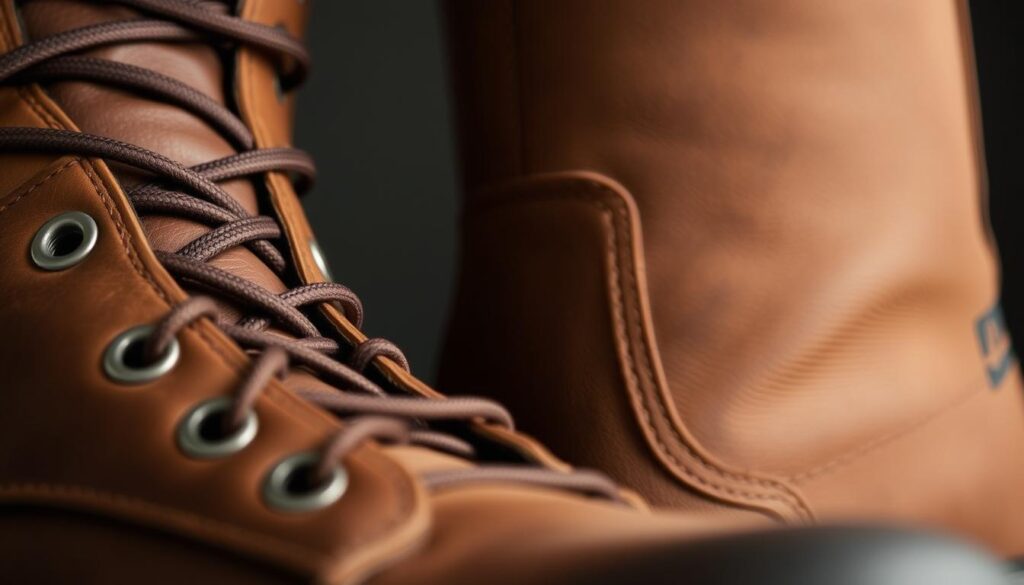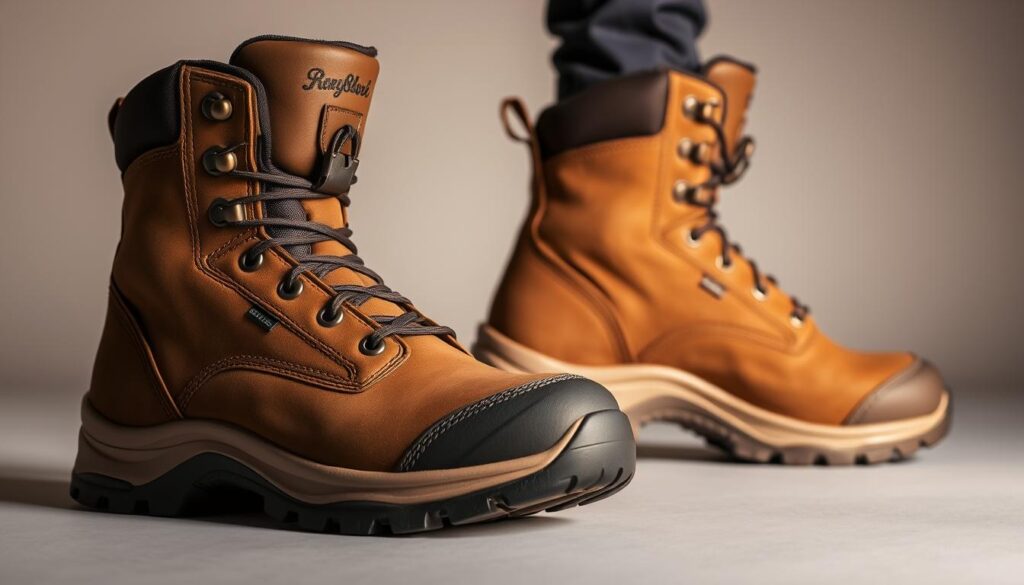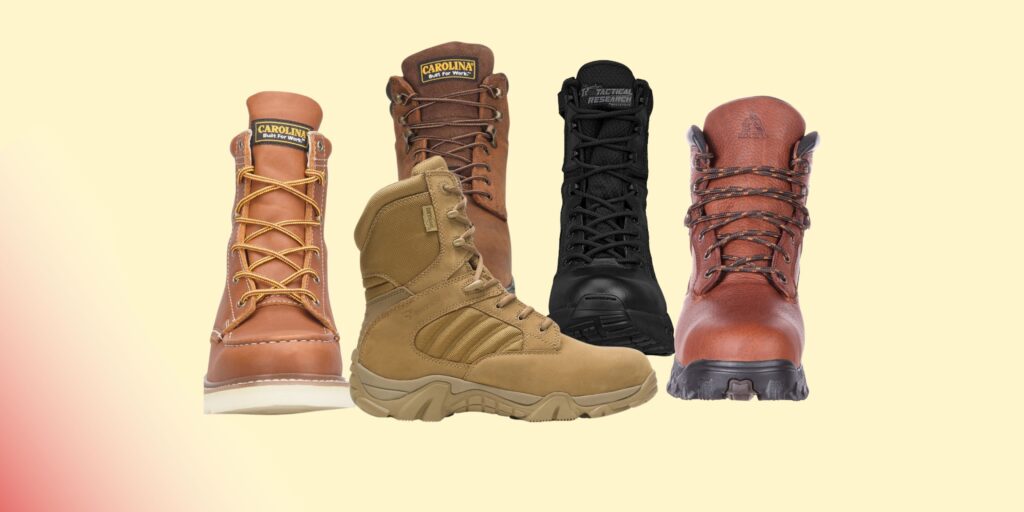Did you know that tactical boots typically weigh under two pounds per pair, making them significantly lighter than combat boots? Choosing the right footwear is crucial for both performance and comfort, especially when your activities demand durability and support.
We aim to help you understand the key differences between tactical and combat boots. Each type is designed for specific purposes, with unique features that cater to different environments and needs. From material quality to construction, we’ll break down what sets them apart.
In this guide, we’ll explore essential aspects like weight, comfort, and protection. Whether you’re looking for agility in urban settings or robust support in harsh terrains, our comparison will help you make an informed decision. Let’s dive into the details to find the perfect pair for your needs.
Key Takeaways
- Tactical boots are lighter, often weighing under two pounds per pair.
- Combat boots prioritize durability and protection in extreme conditions.
- Material quality varies, with tactical boots using lightweight synthetics and combat boots relying on heavy-duty leather.
- Comfort features like breathable mesh are common in tactical boots.
- Combat boots offer enhanced ankle support for intense activities.
Overview of Tactical and Work Boots
Footwear designed for specific tasks can significantly impact performance, and tactical and work boots are no exception. Each type is engineered to meet unique demands, whether in rugged terrains or industrial environments. Understanding their distinct features and purposes is key to selecting the right pair for your needs.
Defining Tactical Boots and Their Uses
Tactical boots are crafted for versatility and agility, making them ideal for a range of activities. They are often lightweight, with materials like nylon and synthetic leather reducing overall weight. This design enhances mobility, especially in urban or training environments.
These boots prioritize comfort and performance, incorporating features like breathable mesh panels and moisture-wicking linings. Such elements keep feet cool and dry, even during extended wear. Additionally, they often include cushioned insoles and padded collars for added support.
Commonly used by military personnel, law enforcement officers, and outdoor enthusiasts, tactical boots are designed to withstand harsh conditions. Their durability and flexibility make them a top choice for those who need reliable footwear in challenging environments.
Understanding Work Boots in Today’s Industry
Work boots, on the other hand, are built for heavy-duty tasks in industrial and outdoor settings. They are typically constructed with high-quality leather and reinforced materials to ensure long-lasting durability. This robust design provides excellent protection against abrasions and impacts.
One of the standout features of work boots is their enhanced ankle support, which helps prevent injuries during intense physical activities. They also often include waterproofing membranes and insulation, making them suitable for extreme weather conditions.
These boots are favored by construction workers, loggers, and others in demanding professions. Their focus on protection and durability ensures they can handle the toughest job requirements.
| Feature | Tactical Boots | Work Boots |
|---|---|---|
| Material | Nylon, synthetic leather | High-quality leather, reinforced materials |
| Weight | Lightweight (under 2 lbs) | Heavier (4-6 lbs) |
| Primary Use | Versatile activities, urban environments | Industrial tasks, outdoor work |
| Comfort Features | Breathable mesh, moisture-wicking lining | Waterproofing, insulation |
| Protection | Flexible, shock-absorbing | High impact resistance, ankle support |
In summary, tactical boots excel in agility and comfort, while work boots prioritize durability and protection. Your choice depends on the specific demands of your environment and activities.
Design Elements and Material Quality
The design and materials of footwear play a pivotal role in determining its performance and longevity. Whether you’re navigating rugged terrains or working in industrial settings, the right construction and material quality can make all the difference.

Construction and Materials Explained
Footwear construction involves a combination of techniques and materials tailored to specific needs. For instance, tactical boots often use lightweight synthetics like nylon and synthetic leather. These materials enhance mobility while maintaining durability.
On the other hand, work boots are typically built with high-quality leather and reinforced materials. This ensures they can withstand harsh conditions and heavy-duty tasks. The stitching and sole composition also differ, with work boots featuring thicker soles for added protection.
Durability Considerations and Wear Patterns
Durability is a key factor when choosing the right footwear. Tactical boots, designed for agility, may show wear in high-flex areas like the toe and ankle. However, their breathable linings and moisture-wicking features help prolong their lifespan.
Work boots, with their robust construction, are built to endure extreme wear and tear. They often feature reinforced toes and puncture-resistant soles, making them ideal for demanding environments. As one expert noted,
“The right material choice can significantly impact how long your boots last and how well they perform.”
Understanding these differences helps you select footwear that meets your specific needs. Whether you prioritize agility or durability, the right materials and construction techniques ensure your boots perform optimally in any condition.
Performance, Comfort, and Functional Features
Modern footwear integrates cutting-edge technologies to meet the demands of active lifestyles. Whether you’re navigating rugged terrains or working long hours, the right design and materials can significantly enhance your experience. Let’s explore the key features that make these products stand out.
Mobility and Flexibility for Active Use
Footwear designed for active use prioritizes mobility and flexibility. Advanced materials like lightweight synthetics and flexible soles allow for a wide range of movement. This is especially beneficial for activities requiring quick turns or extended periods of walking.
For example, models with reinforced toe caps and shock-absorbing midsoles provide stability without compromising agility. These features ensure your feet remain protected while maintaining optimal performance.

Breathability and Cushioning in Extended Wear
Comfort is crucial for extended wear, and modern footwear excels in this area. Breathable linings and moisture-wicking fabrics keep your feet cool and dry, even in challenging conditions. This prevents discomfort and reduces the risk of blisters.
Additionally, advanced cushioning systems, such as memory foam insoles, provide exceptional support. These features are designed to reduce fatigue, making them ideal for long hours of use. As one expert noted,
“The right combination of breathability and cushioning can transform your experience, ensuring comfort and performance in any environment.”
- Lightweight materials enhance agility and reduce strain.
- Moisture-wicking linings prevent sweat buildup.
- Cushioned insoles offer superior support for extended wear.
By focusing on these functional features, modern footwear delivers unmatched performance and comfort. Whether you’re on the job or exploring the outdoors, these innovations ensure your feet stay protected and supported.
Tactical Boots Compare to Work Boots: Key Differences in Application
Choosing the right footwear for specific tasks can significantly enhance performance and safety. Tactical and work boots are designed for distinct purposes, each excelling in different environments and activities. Understanding their applications helps you make an informed decision based on your needs.
Suitability for Job Requirements and Outdoor Activities
Tactical boots are ideal for dynamic environments where agility and comfort are paramount. They are commonly used by law enforcement officers, military personnel, and outdoor enthusiasts. Their lightweight design and breathable materials make them perfect for extended wear in urban or training settings.
On the other hand, work boots are built for heavy-duty tasks in industrial or rugged outdoor environments. Construction workers, loggers, and others in demanding professions rely on their durability and protection. Features like reinforced toes and waterproof membranes ensure they can withstand harsh conditions.
“The right boot choice depends on the demands of your environment. Tactical boots offer flexibility, while work boots provide unmatched durability.”
Here’s a quick comparison of their key features:
| Feature | Tactical Boots | Work Boots |
|---|---|---|
| Primary Use | Urban operations, training | Industrial tasks, rugged terrains |
| Material | Lightweight synthetics | High-quality leather |
| Weight | Under 2 lbs per pair | 4-6 lbs per pair |
| Comfort | Breathable lining, cushioned insoles | Waterproofing, insulation |
| Protection | Flexible, shock-absorbing | Reinforced toes, ankle support |
For example, tactical boots are preferred for activities requiring quick movements, such as hiking or urban patrols. Their lightweight construction and breathable materials keep feet comfortable during long hours. In contrast, work boots excel in environments where foot protection is critical, such as construction sites or logging operations.
Ultimately, the choice between tactical and work boots depends on your specific needs. Consider the environment, activity, and level of protection required to find the perfect pair for your tasks.
Choosing the Right Boot for Your Needs
Selecting the right footwear for your daily activities can make a significant difference in performance and comfort. Whether you’re navigating rugged terrains or working in demanding environments, understanding your specific needs is crucial. We’ll guide you through the process of assessing your requirements and balancing key features to find the perfect pair.
Assessing Your Environment and Daily Demands
Start by evaluating the conditions you’ll face. For urban settings or training environments, lightweight options with breathable materials are ideal. These provide the agility and comfort needed for extended wear.
In contrast, industrial or outdoor work often requires robust designs with reinforced toes and waterproofing. These features ensure your feet stay protected in harsh conditions. As one expert noted,
“The right boot choice depends on the demands of your environment. Lightweight designs offer flexibility, while heavy-duty options provide unmatched durability.”
Expert Tips to Balance Protection and Comfort
When choosing footwear, consider the balance between protection and comfort. Look for features like cushioned insoles and moisture-wicking linings to keep your feet comfortable during long hours. These elements reduce fatigue and prevent discomfort.
Additionally, prioritize material quality and construction. High-quality leather or synthetic materials ensure longevity, while reinforced soles offer stability. Proper care, such as regular cleaning and conditioning, can also extend the life of your boots.
- Evaluate your activity level and environment before making a decision.
- Choose designs with breathable materials for extended wear.
- Prioritize reinforced features for demanding tasks.
- Maintain your boots regularly to ensure long-lasting performance.
By following these expert tips, you can find footwear that meets your specific needs. Whether you prioritize agility or durability, the right choice ensures your feet stay protected and supported in any condition.
Conclusion
Finding the right footwear for your needs ensures both performance and comfort in any environment. Tactical boots excel in agility and breathability, making them ideal for dynamic activities. In contrast, combat boots prioritize durability and protection, suited for harsh conditions.
Material quality plays a significant role in determining longevity and performance. Lightweight synthetics in tactical boots enhance mobility, while heavy-duty leather in combat boots ensures resilience. Both types offer unique features tailored to specific demands.
When choosing, consider your environment and daily tasks. For urban settings or training, tactical boots provide unmatched flexibility. For rugged terrains or industrial work, combat boots deliver superior protection.
We recommend evaluating your needs carefully. Explore further resources and expert advice to make an informed decision. The right choice ensures your feet stay supported and protected in any situation.

